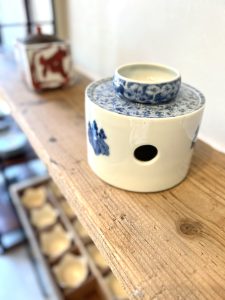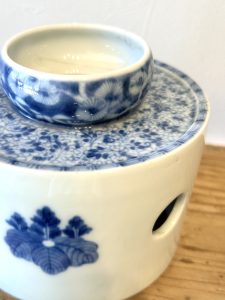当たり前ではない平和な光景です(愛知県名古屋市千種区姫池通 骨董買取 古美術風光舎)
2024.05.21
みなさまこんにちは。スタッフHでございます。
少しずつ夏の気配がしてきましたが、まだ空気はカラッとしていて気持ちの良い朝でした。これに湿気が加わると発汗が抑えられ、熱中症の危険性が高くなるといわれています。気温だけでなく湿度にも注意が必要なのですね。過信は禁物だと自分に言い聞かせています。
先日小ぶりの盃台について綴りましたが、こちらの少し大きめの盃台も仲間入りしております。


絵柄が緻密に描かれており、白い余白とのコントラストが爽やかな印象で、飾っておくだけで存在感があります。盃台には本当に色々なサイズや形があるのですね。
さて昼を過ぎる頃から風光舎の店の前を元気な小学生たちが下校する姿が見られます。こっそり観察していると後ろを向いたり、立ち止まったり、道の端から端をジグザクに歩いたりと真っすぐにあるいている子の方が少ないような…。真っすぐ歩くことが当たり前になってしまった大人としては少し羨ましい気もします。
ちなみに本日5月21日は、「小学校開校の日」だそうです。それまで旧幕臣の子弟たちを対象にした学校はあったようですが、地域の子供が誰でも通えるような「公立小学校」はなかったようで、明治2年(1869年)5月21日、京都に「上京第二十七番組小学校」が開校しました。これは明治政府が小学校教育を義務付けた「学制」を公布するより3年前の出来事だったそうです。
幕末の動乱により京都の町の大半が焼けてしまい、明治維新で都が京都から東京へ移ったことで京都の人口が激減し、経済が衰退していきました。そんな中、行政と京都の町衆たちが寺子屋にかわり、子供たちが等しく教育を受け国内外の文化や歴史を学べる場所を作ろうと動き出したそうです。
資金調達に重要な働きをしたのが「番組制度」で、町の自治組織の番組ごとに資金を出し合ったとのこと。硯や筆なども資金から購入され、合計64校もの小学校が次々と建てられたそうです。
京都の西陣織や清水焼などの伝統産業を引き継いでいく人材を育てるために、当時から日本画などの美術に関する授業も取り入れられました。その結果、卒業生には北大路魯山人などの芸術家も多く輩出され、寄贈された作品が校内に飾られているとか。羨ましい環境ですね。京都の人々の懐の深さや団結力を感じます。
小学生の甲高い元気な声を聞いていると、当たり前に学校に通えることに感謝したくなります。しかも日本のように子供が大人の付き添いなしで外を歩ける国は少ないといいます。日本に来たばかりのアメリカ人のタレントさんが、一人で下校している小学生を見かけ、誘拐されないか心配で家まで着いて行ったそうです。屈強な欧米人が子供の後ろをついて歩く姿もちょっと怪しげな気もしますが…。それくらい珍しい光景なのでしょう。
また4、5歳の子供が財布を首から下げて一人でおつかいをする日本のテレビ番組(もちろん大人が見守っています)「はじめてのおつかい」が海外で人気のようですが、幼児をおつかいに出そうという発想が現実離れし過ぎて、もやは架空の世界にも見えるとか。
子どもたちにとって安全な日本の環境がいつまでも続きますように。
それでは、また次の機会に。
Hello everyone. This is Staff H.
It was a pleasant morning with the air still dry and crisp, although summer is gradually beginning to show itself. It is said that when humidity is added to this, it suppresses sweating and increases the risk of heat stroke. So we need to pay attention not only to temperature but also to humidity. I tell myself not to be overconfident.
The other day, I wrote about small sake cupholders, and this slightly larger one has joined the lineup.
The elaborate patterns on these pieces contrast with the white margins, giving them a fresh impression and making them stand out just by displaying them. Sake cup stands come in a variety of sizes and shapes.
After midday, we see cheerful elementary school students leaving school in front of the Fumikosha store. I noticed that they were turning around, stopping, or walking in a zigzag pattern from one end of the street to the other, and it seemed that few of them were walking in a straight line. As an adult who has become accustomed to walking straight, I feel a little envious.
Today, May 21, is “the day elementary schools were opened. Until then, there had been schools for children of former shogunate vassals, but there were no “public elementary schools” that any local child could attend, and on May 21, 1869, the “Kamigyo 27th Program Elementary School” opened in Kyoto. This was three years before the Meiji government promulgated the “school system,” which mandated elementary school education.
Most of the town of Kyoto was burnt down during the upheavals at the end of the Edo period, and with the capital moved from Kyoto to Tokyo during the Meiji Restoration, Kyoto’s population declined sharply and the economy declined. Under such circumstances, the government and the townspeople of Kyoto began working to create a place where children could receive an equal education and learn about domestic and international culture and history, instead of a terakoya.
The “program system” played an important role in raising funds, and each program was funded by the town’s self-governing organization. The funds were also used to purchase inkstones and writing brushes, and a total of 64 elementary schools were built one after another.
From that time on, classes on Japanese painting and other art-related subjects were also introduced in order to nurture human resources who would carry on Kyoto’s traditional industries such as Nishijin textiles and Kiyomizu-yaki ceramics. As a result, many of the school’s graduates are artists, such as Kitaoji Rosanjin, and their donated works are displayed in the school. It is an enviable environment. I feel the depth of nostalgia and unity of the people of Kyoto.
Hearing the high-pitched, energetic voices of the elementary school students makes me want to thank them for being able to attend school as a matter of course. Moreover, it is said that there are few countries where children can walk outside unaccompanied by adults like in Japan. An American TV personality once told me that he saw an elementary school student leaving school alone and, worried that he might be kidnapped, followed the child home. It may seem a little suspicious to see a strong Westerner walking behind a child, but…. But it is such a rare sight.
Also, “Hajimete no Otsukai,” a Japanese TV program in which a 4- or 5-year-old child carries a purse around his or her neck and goes on an excursion by himself or herself (watched by an adult, of course), seems to be popular overseas, but the idea of taking a toddler on an excursion seems too far from reality and even fanciful.
I hope that the Japanese environment will remain safe for children forever.
See you next time.
*******************
ご実家の整理やお片付けなどをされている方のご相談などが多くございます。
お片付けなどくれぐれもご無理のないようになさってくださいませ。
風光舎では古美術品や骨董品の他にも絵画や宝石、趣味のお品など様々なジャンルのものを買受しております。
お片付けをされていて、こういうものでもいいのかしらと迷われているものでも、どうぞお気軽にご相談下さいませ。
また風光舎は、出張買取も強化しております。ご近所はもちろん、愛知県内、岐阜県、三重県その他の県へも出張いたします。
まずは、お電話お待ちしております。
愛知県名古屋市千種区姫池通
骨董 買取【古美術 風光舎 名古屋店】
TEL052(734)8444
10:00-18:00 OPEN

